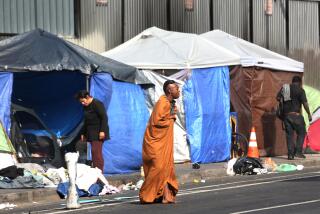42 City-Run Apartments Will Open to Homeless
- Share via
Thousands of homeless living on the streets of Los Angeles will be given free temporary shelter in 42 City Housing Authority apartments under an emergency measure adopted by housing commissioners Thursday.
As many as 250 people at a time will be housed in the apartments, for a maximum of seven days, with priority given to families, single parents with children and people over age 55.
City officials said the first of the temporary residents under the emergency 90-day program may move in today. Deputy Mayor Grace M. Davis said after the decision by the seven-member commission that city officials probably would decide by Thursday night whom to shelter initially.
The approximately 200 people who have spent each of the last three nights in City Hall under a temporary City Council order will be housed beginning tonight in a city-owned building at 411 East 1st St., Davis said.
In a related development, the Los Angeles County Board of Supervisors, citing four hypothermia deaths on streets and in alleys during recent near-freezing nights, voted to send county workers out to try to persuade homeless people to accept emergency housing.
The measure by Supervisor Ed Edelman authorizes teams of social and mental health workers to enter any city that requests the county’s help when temperatures drop to 40 degrees or lower to issue the homeless free vouchers for hotel rooms and to try to persuade them to get off the streets.
The county also will ask schools to open gymnasiums as shelters, the state to open National Guard armories and the county facilities management office to find county buildings available as shelters.
The city housing commissioners’ action meant that thousands of homeless may find short-term shelter during the next 90 days. The motion by Chairman Alvin Greene set aside two apartments at each of the city’s 21 low-income housing projects.
Housing Authority officials said the homeless probably will be allowed to remain for a maximum of seven days, only until longer-term housing can be found for them with the aid of Social Security benefits, welfare and Medicare.
The executive director of the authority, Leila Gonzalez-Correa, said, “We have 30 apartments available right now because of normal rotation, and we hope to have the full 42 apartments for the project available by next week.”
A staff analyst on Gonzalez-Correa’s staff, Steve Renahan, said the cost to the Housing Authority of the emergency program will be covered by its normal budget, which comes in the form of subsidies from the U. S. Department of Housing and Urban Development.
“These apartments are for low-income families,” he said. “The regular residents pay only a percentage of income in rent, so some of them pay very little rent anyway. We don’t expect that there will be extraordinary costs above normal.”
Gonzalez-Correa said HUD had already approved the emergency program and county officials who have been working with the homeless had already promised their cooperation.
“Next week, the Housing Authority will establish an office in City Hall, where the homeless are more or less headquartered,” she said. “County social welfare officials will come in to talk to them and begin processing them into the county system to receive welfare, Social Security, Medicare or any other assistance for which they are qualified.”
Greene said the emergency project is purely “a temporary, partial solution. Obviously, it does not solve the problem of the homeless in Los Angeles. . . . We believe there are 30,000 homeless in this city, so what we are doing is just a drop in the bucket.”
The Housing Authority, he said, controls 8,700 units of housing in the 21 projects scattered throughout the city. To solve the present homeless problem, he said, Los Angeles would have to double the number of low-income residences it has accumulated over 50 years.
“The Housing Authority does not have that kind of money,” he said. “We are really a property management agency. We have no funds for new construction. . . .”
The county, under an amendment to the emergency outreach measure adopted by the supervisors, also will pursue state legislation allowing it broad powers to involuntarily commit the mentally ill homeless to hospitals.
The 3-0 vote on the outreach proposal, with Supervisor Pete Schabarum absent and Supervisor Kenneth Hahn in the hospital recovering from a stroke, was hailed by Edelman and by a spokesman for the homeless as a milestone in the county’s efforts to grapple with the problem of street people.
Edelman, who has spearheaded many failed attempts to enact emergency help for the homeless in the last year, said: “I want to thank my colleagues. . . . I think I got recognition here, for the first time, that we are simply not doing enough.”
Edelman said a county survey this week discovered 150 empty beds in the downtown area that are not being used by the homeless, who are either unable to find them or unaware that they exist.
“We have got to link beds to people, and we’ve got to find more beds,” Edelman said. “We are not talking about balmy weather, we are talking about people dying of hypothermia.”
Edelman said the outreach approach “was a big success” when first used by the county the night of Jan. 6, after nighttime temperatures plummeted to record lows. Special teams of Department of Public Social Services workers were sent to Tent City II, where they passed out 69 hotel vouchers to people huddling in the cold. Of those passed out, 56 were used.
More to Read
Sign up for Essential California
The most important California stories and recommendations in your inbox every morning.
You may occasionally receive promotional content from the Los Angeles Times.













